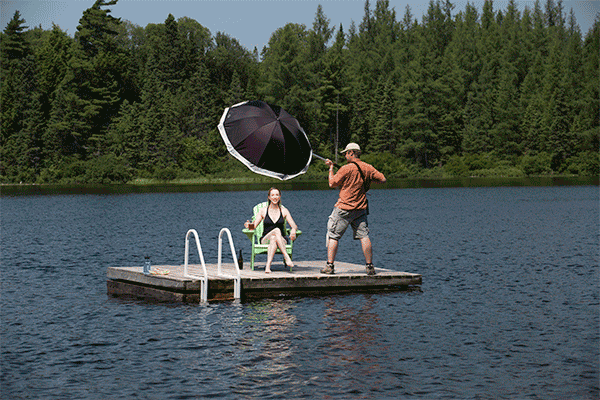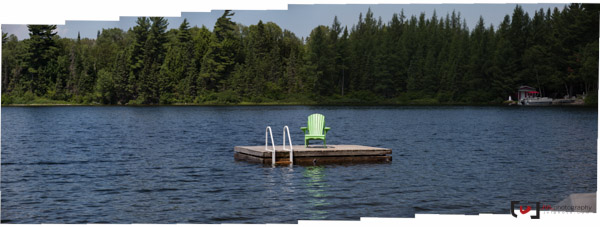
Some people just prefer to be in the water.
For the third year in a row (I think I’m onto something here), Julie Cole invited me to come photograph her wonderful family of 8. For the second year in a row, they chose to do it in their bathing suits. Julie and I realized the logistical issues of shooting in October and in a pool – even though the kids loved it – so we went for a summer shoot, this time at their remote and lovely cottage.
Because Julie and her family are incredibly kind and gracious hosts, they invited my family along for the trip. I didn’t know where we were going to shoot at the cottage, or what the cottage looked like. I just knew that their family was really excited, my family was really excited, and that I was going to need an assistant who could travel into cottage country with me for a few days.
We truly could not have pulled off this shoot without Alex. Thankfully, Alex is a dad to a lovely little girl, so he was a friendly and trusted companion to hang out with a gaggle of Cole-Kids. He was even able to tolerate my own two boys for the long drive, which is more than I can say for my wife who took one for the team and rode between the two car seats.
The trip was four days: one day out, two days there, and another day for the return. The first night at the cottage, which was the first time I’ve been away from a city in a very long time, I tried my hand at some night-time astrophotography. We stayed up late, drank some beers, stared at the fire, and caught up on a year’s worth of parenting. Little did I know what they had planned to tell me the next day.
Morning started like any good day at the lake should: “shaking the cobwebs off” with a cool swim, lots and lots of bacon, kids everywhere, and a special “Floot Loops” cottage treat. They had a new puppy too… “Great!” “He’ll be in the photo.” “No problem!” “We were thinking about it being out on the floating dock.” “Oh.”

Let me explain something about the work I do here. The composite photos need to blend near-seamlessly together to be convincing. Some of my work is better than others and I’ve been able to understand that most issues are caused by the number of variables introduced into a shot. The more variables, the more there are chances of things going wrong, or at the very least, the more time you’ll have to spend trying to fix it in post. The variables on an indoors shoot are less than the variables of an outdoor shoot. The variables on a loosely anchored floating dock in the water on a day with variable clouds, eight people, and a dog, are much, much more complicated. Of course, we were up to the challenge.

I packed light for this trip, or at least light for me. I knew we’d be shooting outdoors, during the day and at a location with no electricity. So, I only brought my Elinchrom Ranger Quadras since they have 4 to 5 times the power of my speedlights, and, between their three batteries, I was confident we’d have enough juice to get the shots we needed. Of course, getting 400W of lighting battery-pack power out to a small dock was a bit more complicated. The water was deep enough that there was no way we could get a lightstand in the water, and the potential layout of the shoot had some of the kids doing stuff in the water, and completely away from the dock. Maybe we could have used the sun as our key-light and something as simple as a reflector to fill it in, but the sun was inconsistent, and coming from camera-left. The only logical solution was to put our Voice-Activated-Lightstand (VAL, read: assistant) on a floating “barge” (read: paddleboat) and hope he didn’t fall in.

Did I mention there was wind? Here’s a logistical problem: your supposed-to-be stationary stand is on a boat and his 60″ umbrella just became a giant sail. See ya later Alex!
Good thing these kids are water-babies. As we were working with one, the others were in the water acting as tug-boats to our floating light barge, keeping it in place and moving it into position. If we needed a fishing pole bent they’d grab the end and pull it under (hook removed of course).
A second logistical issue was the full sun we’d be working in. My Elinchrom Ranger Quadras can get a decent power output: enough to augment full sun but not necessarily in a way that I’d be able to under-expose the background mid-day. I wanted the background to retain all detail (not go white and “blown out”) while using an aperture that gave me a good range of the family in focus, but slightly blurred the trees on the other side of the lake. My camera’s maximum shutter sync with the Quadras is normally around 1/160th of a second, but with the Pocket Wizard MiniTT1 and FlexTT5, I’m able to boost this using their hypersync technology to about 1/500th. This fast shutter speed lets me boost my ISO so I can *also* increase my depth of field adequately while getting the flash balance on the subjects I like. We’re on the edge here. Any faster and it’s too dark, the flash won’t sync with the shutter and the subjects will go dark. Open up my aperture and I lose focus and detail on the family. Change my ISO and things get too bright or too dark.
Oops, turned out we were a bit on the dark side. That’s okay though, I’d rather be able to bring dark areas up in post-production than lose highlight detail and not be able to recover it. In Lightroom, I brought the shadows up quite a bit while keeping my “highlights” slider down to keep the family and other hot-spots from blowing out. I quickly go through all the images to weed out ones where the flash didn’t go off, someone wasn’t in place, or they just all-around look so terrible there’s no way we’ll use it. I flag them red as “selects” and group them together.

Let’s rewind a bit. After I completed my shoot at the lake with the family, I created a background panorama of the location. I wanted to make sure I had a consistent and clean background to work with. I knew clouds had been flying in and out all day and that the backgrounds of the family wouldn’t necessarily match-up when I tried to stitch them together. Thankfully, when working with flash, that light is a constant, so each member of the family would be relatively consistently lit.
That pano is my first step in Photoshop. I “merge to pano” out of Lightroom and let Photoshop work its stitching magic. I’ll clone any anomalies out and then flatten the layer.
The next stage is adding and masking all the family members into the background. Working on-location has the benefit of giving everyone the proper perspective (relative to the camera) as well as other subtle details like colour cast from the water and green reflections from the chair. I added them all as smart-objects in Photoshop and manually layered them over the background image since you can’t auto-allign smart objects.. The smart objects let me play around a bit with each image’s exposure and shadow detail to better blend it in with the background. Once I think I have a good match, I meticulously mask around every subject using my Wacom tablet and a brush. This took about five hours.

Once everyone’s masked and looking good on the image, I spend some time dodging and burning certain areas that need a boost, doing some minor skin re-touching, and cloning out other distracting background objects (including an entire cottage on the other side of the lake). I play around with tones, contrast, and play around with some filters until I get a look that I think is right. Then I walk away from the image: by now I’ve spent about 10 hours at my computer building it and I’ve seen way too much.
After a day, I can stand to look at my screen again to make a few adjustments and crops, hope for the best, and send it to Julie. Every minute she doesn’t respond I think it’s a minute she’s cursing my name. Until I get the reply: “SO EFFING GOOD!!!!!”
12 Hours of driving, 8 kids, 1 dog, 5 adults, one light, 3 hours on a lake, 10 hours in Photoshop, 3GB PSB large document file: mission accomplished. This is standard-fare for a commercial photographer, but it’s still not what most families anticipate when getting their portraits done. I can’t wait to see the print, but for now, checking it out bigger on Flickr will suffice.